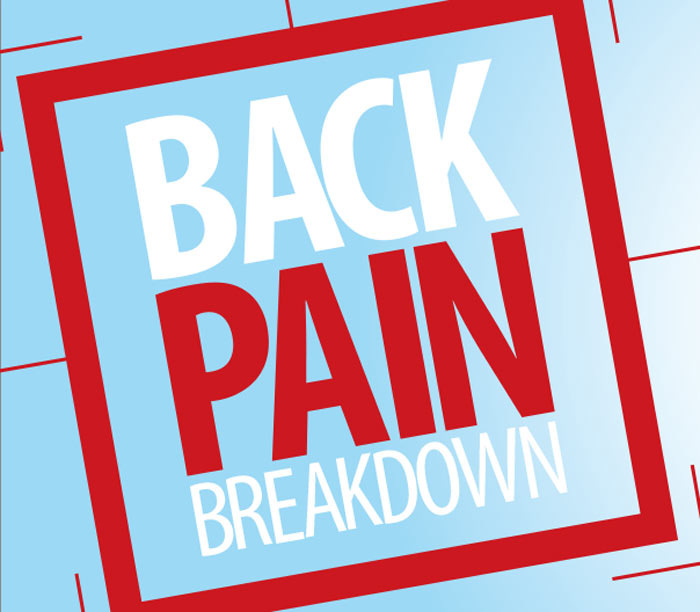
Back pain is common. It accounts for over 3 million emergency room visits in the United States each year. Globally, it affects 84 percent of people at some point during their lifetime,the University of Maryland Medical Center reports. The widespread scope of the back-pain problem has prompted the development of a variety of treatments, including natural ways to help alleviate the pain.
From preventing to treating existing back pain, we’ve got your back on how to relieve some of the most common types of back pain. With advice from local specialists, including Dr. YiLi Zhou, M.D., Ph.D., from Florida Pain and Rehabilitation Center and Dr. Joseph Stanfield from Stanfield Chiropractic, you’ll be back up and at it in no time. First, it’s back to the basics.
ho gets back pain? Back pain can strike a nerve with anyone, but there are certain characteristics that can increase your risk or even worsen your existing back pain. The most common risk factor is, not surprisingly, age. The constant wear and tear from day-to-day tasks can start to breakdown your back. Pain caused by age usually develops between age 30 and 40, depending on other influencing factors such as heredity and bone health.
Poor physical fitness and being overweight are both factors that can contribute to back pain. You can help limit the damage those extra pounds can do to your back with diet and exercise. Weight training and physical therapy can help strengthen the muscles around the spine, which can help prevent the pain.
If you’re a smoker, beware. Not only does smoking damage your lungs, cause heart disease and make you smell awful, it can also increase your risk of developing back pain. Smoking can block nutrients from getting to the spine, which can cause pain, and because smokers may be slower to heal, the pain can last longer, according to the National Institute of Arthritis and Musculoskeletal and Skin Diseases. Combine these factors with a smoker’s cough and it’s more than enough reason to ditch the sticks.
As expected, jobs that require constant lifting, twisting and pushing can take a toll on your spine. However, even a desk job can do damage. Sitting at a desk all day can be just as bad on your back, especially when poor posture is involved.
The Aches And Pains Of Strains
Strains occur when a muscle or tendon is stretched or torn. The lower back is a common location for strains and can cause mild, moderate or severe pain. The pain is usually spread out, affecting the muscles close to the spine and sometimes causing those muscles to spasm. Strains can also cause inflammation and sometimes even bruising around the injured area.
The fix:
Mild strains can be treated at home. Use the R.I.C.E. approach—rest, ice, compression and elevation. An over-the-counter pain reliever such as ibuprofen (Motrin) or acetaminophen (Tylenol) can help with the ache.
M.D.:
If the strain is more severe, a trip to your primary physician is your best bet. Your physician may refer you to a doctor that specializes in sports medicine.
Are you prone to strains? Lack of regular exercise and conditioning can hurt more than just your beach bod. Your muscles are more likely to sustain injury when they’re weak. If your occupation requires rigorous physical activity, proper conditioning can help prevent strains and other injuries to your back.
Go Natural:
Exercise on a regular basis. The Department of Health and Human Services says that healthy adults should do at least 150 minutes of moderate aerobic activity such or 75 minutes of vigorous aerobic activity a week along with strength training at least twice a week.
Some examples of aerobic activity include walking, bicycling, swimming or jogging. However, you should always consult your doctor before beginning an exercise regimen.
As for strength training, a gym membership or pricey weight machines aren’t necessarily needed. Using your own body weight or inexpensive dumbbells can be an alternative way to strengthen back muscles. Try these at-home exercises from the American College of Sports Medicine to strengthen your core and back muscles:
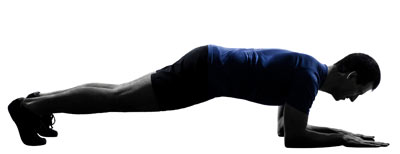
The plank: Start by lying facedown with your forearms and palms flat on the floor. Lift up onto your toes, and rest on your elbows. Keep your back straight and flat, and hold this position for up to 60 seconds.
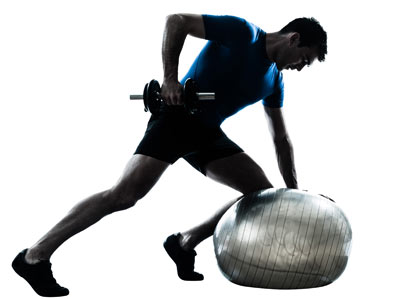
Dumbbell row: Start by standing with feet shoulder-width apart. Hold a dumbbell in each hand with elbows slightly bent. Lean forward at the waist, and slightly bend your knees. Pull the dumbbells up to your sides until your upper arms are just about parallel to the floor, and slowly return the dumbbells to the starting position.
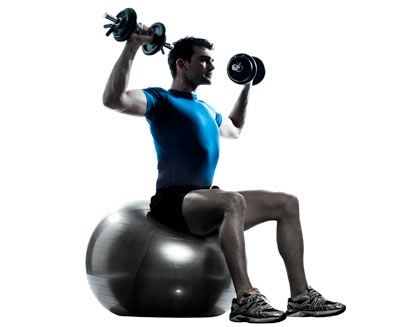
Dumbbell Shoulder Press: Start by sitting in a chair, on a stability ball or standing. Using an overhand grip, hold a dumbbell in each hand. Make a 90-degree angle with your arms by raising the dumbbells so they are level with your ears. Then, raise the dumbbells over your head until your arms are fully extended. Do not lock your elbows. Slowly lower the dumbbells to the starting position.
Don’t overdo it, and always allow your muscles to fully recover after strenuous activity. Muscles that are overworked and fatigued are less likely to provide support, which can lead to strains.
Oh, Osteoarthritis
Osteoarthritis is the most common type of arthritis, and it is caused by damage to a joint’s cartilage. Some may also refer to osteoarthritis as degenerative arthritis or degenerative joint disease. The damage can either occur by a joint injury, infection or it can be the result of many years of wear-and-tear.
When osteoarthritis occurs in the spine, it usually affects the lower back and neck. The cushiony disks between your spine’s vertebrae can become dry with age and shrink. Slowly, your spine can stiffen. The deterioration of the cartilage can cause bone-on-bone grinding that can cause pain and loss of flexibility.
The fix:
Nonsteroidal anti-inflammatory drugs, or NSAIDs, are commonly used to relieve pain and swelling in all types of arthritis. Over-the-counter NSAIDs, such as ibuprofen, naproxen and aspirin, are available without a prescription. However, always make sure to consult your doctor before starting over-the-counter NSAIDs because they can interact with other drugs or cause serious side effects, such as stomach bleeding and an increased risk of cardiovascular problems. Prescription NSAIDs are also available through your doctor.
M.D.:
Visit your primary care physician first; he or she may refer you to a rheumatologist. A rheumatologist is a doctor who specializes in the treatment of joint problems.
Go Natural:
Yoga may help improve joint flexibility and range of motion in arthritis sufferers. One study published by the Journal of Rheumatology showed significant relief in joint tenderness and pain during activity among arthritis sufferers who tried yoga technicians for six weeks.
The slow, stretching poses in yoga gently work to relieve stiffness by keeping the spine limber. Yoga poses also work by maintaining the normal joint motions of the back and strengthening the muscles surrounding the spine. Kick-start your new yoga lifestyle with these two simple yoga poses for better back health:
Child’s pose: Sit on the floor with your legs folded underneath your body, with your shins touching the mat. Rest your bottom on your ankles, and slowly lean forward until your forehead touches the mat. Lastly, place your arms with hands facing up beside your body and hold.
Crocodile twist: Lay flat on your back with your arms open. Lift your legs above your body, and bend your knees at a 90-degree angle. Twist your body at the hips to one side and rest the side of your leg on the mat and gently turn your head the opposite direction. Hold. Then slowly switch sides. You can roll up a towel and place it under your neck for more comfort.
Sciatica
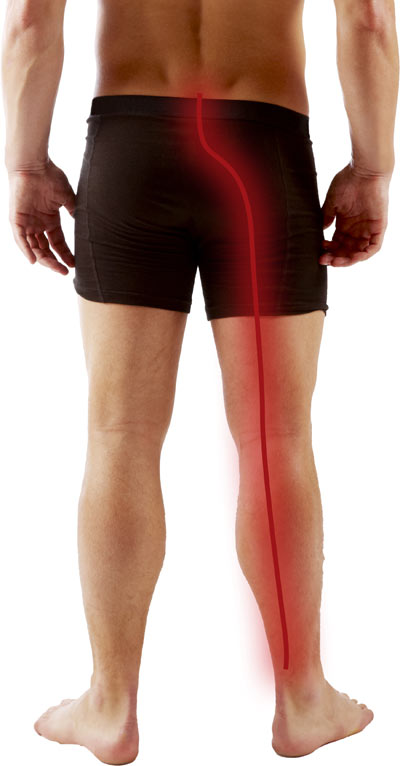
The sciatic nerve is a large nerve that forms near the spine, travels through the pelvis and extends to each buttock. From there, the sciatic nerve travels down each leg. Sciatica usually affects only one side of the body, but the pain can travel the entire length of the nerve. Sciatica causes inflammation and usually numbness in a leg. The sciatic nerve is the longest and widest single nerve in the body, which is why pain here can escalate to the level of becoming debilitating.
Sciatica, however, is only a description of symptoms—not a diagnosis. Sciatica can stem from anything that places pressure on a lumbar nerve root and can cause pain in the sciatic nerve. The most common cause of sciatica is when a bone spur or herniated disk places pressure on the nerve.
The fix:
Your physician might first prescribe medications to help reduce the pain caused by sciatica. Because sciatica can be caused by many different problems, your doctor will choose the most effective type of medication for your situation. Your physician may prescribe a muscle relaxant, antidepressant, anti-seizure medication, anti-inflammatory medication, narcotic or a mixture of two or more of these medications.
In some instances, a doctor may want to find out what is causing the sciatic pain and can order a MRI or CT, according to Dr. Zhou.
“If the MRI or CT found a disc herniation, and the doctor believes a disc herniation is mechanically or chemically irritating the sciatic nerve, the doctor may suggest a lumbar epidural steroid injection or LESI,” Dr. Zhou says, “The steroid can reduce the nerve root irritation or inflammation caused by disc herniation.”
Patient response to LESIs varies. Some may experience several months to even years of back pain relief or no relief at all, according to Dr. Zhou. However, the number of steroid injections you can receive is limited because the risk of side effects increases when injections are given too frequently. If the pain continues after six weeks of treatment, your doctor may require surgery to relieve the pressure placed on the nerve.
When the pain subsides, physical therapy may be recommended by your physician. Physical therapists can construct a rehabilitation plan to prevent sciatic pain from recurring. The plan will most likely include exercises to help strengthen the muscles that support your back, improve posture and expand your range of flexibility.
M.D.:
Visit your primary care physician. He or she may refer you to a chiropractor or spinal surgeon based on your individual needs.
Go Natural:
Chiropractic services can offer healing benefits that bypass or enhance the use of prescription medicine. Your doctor may refer you to a chiropractor as part of his treatment plan. Chiropractors use a variety of natural techniques to help resolve many different back pain issues, including nerve irritation, disc herniation and bulges, muscle spasms, sciatica and rib-joint pain, Dr. Stanfield says.
Chiropractors may use physical therapy, ultrasound, electric stimulation, mechanical traction and massage therapy in their offices in conjunction with chiropractic adjustment.
“When joints of the body where the bones come together become partially dislocated causing nerve interference it is called a subluxation,” Dr. Stanfield explains, “Chiropractors are uniquely trained to locate and correct subluxations to remove the nerve interference that causes discommunication between the brain and the body.”
Restoring communication with the chiropractic adjustment relieves the symptoms of pain, spasm, organ dysfunction, swelling, tissue irritation and stiffness caused by the subluxation, according to Dr. Stanfield.
Talk To The Doc
The first step to resolving back pain is talking to your doctor. Upon diagnosis, your doctor will decide a treatment plan tailored to your needs. Talk to your doctor about the natural techniques, such as these, to help combat your back pain.
Sources: mayoclinic.org, acsm.org, webmd.com, spine-health.com, howstuffworks.com






